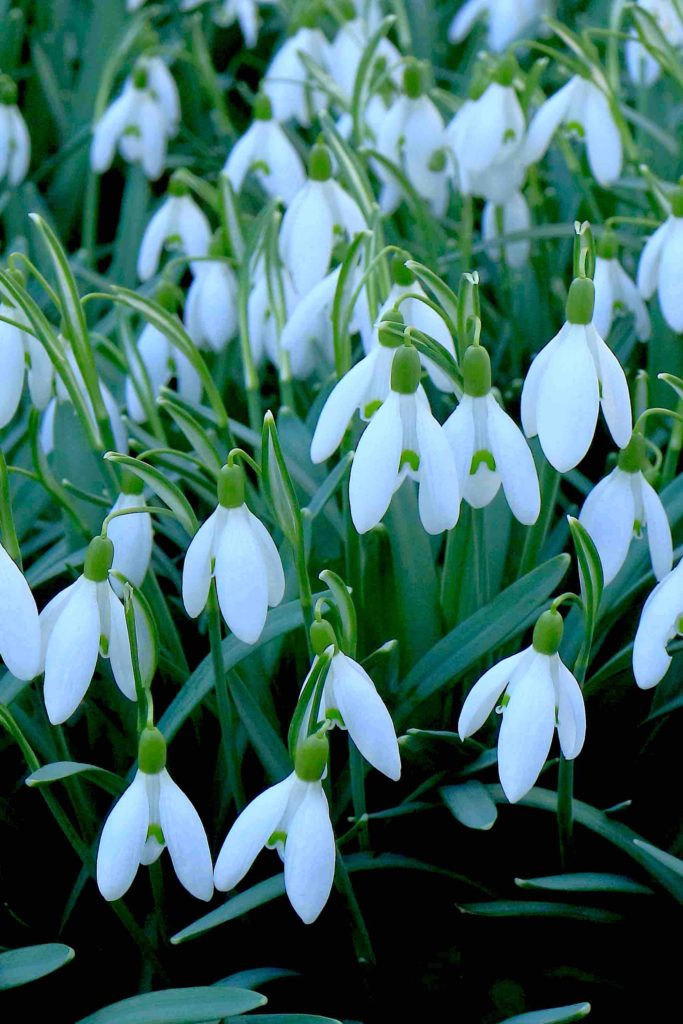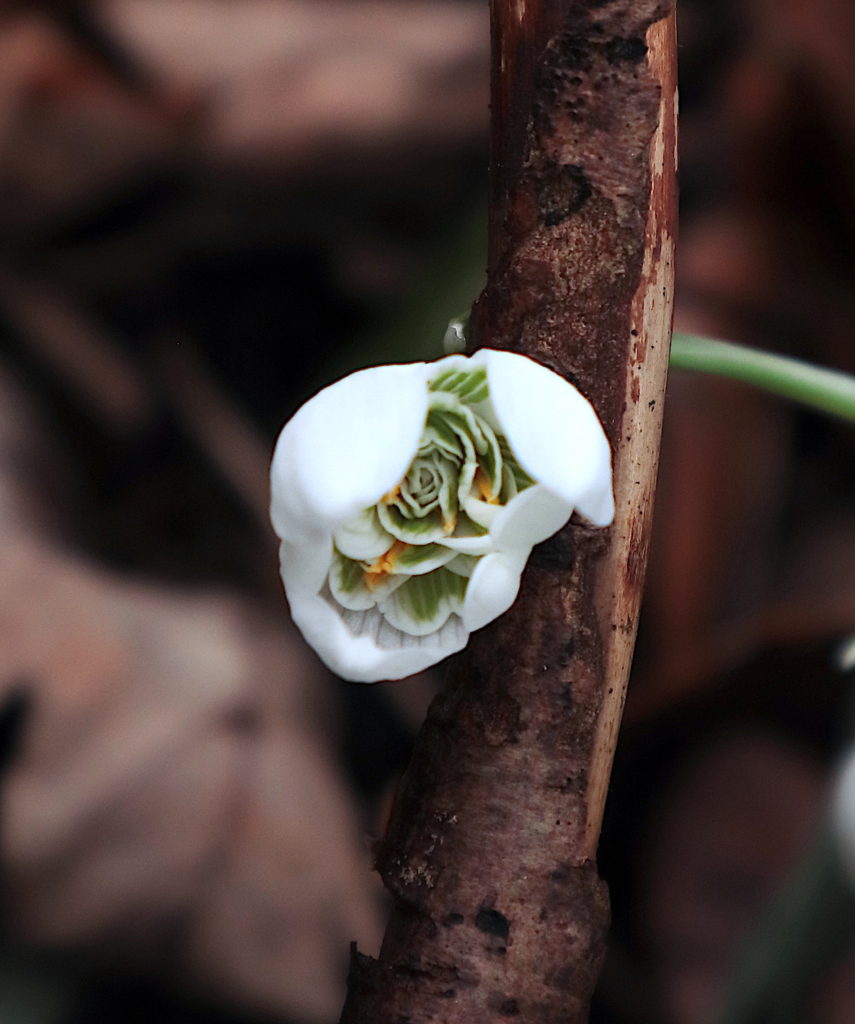⇠ back to “Look out for…”
[NB: open any photo with click/tap for an enlarged version in a new tab.]
Snowdrop Galanthus nivalis
Identification
In Cumbria, the vast majority of snowdrops, both cultivated and established anywhere beyond gardens, are the familiar Galanthus nivalis. It is nowhere native, but is well-naturalised, and is probably still spreading, although most colonies are close to gardens on lane- and road-sides, sometimes advancing into woodland and parkland, or where dumped on waste ground. By contrast, bulbs have been very widely dispersed downstream along water-courses to colonise more ‘natural’ habitats of stream- and river-banks.
Are there other species naturalised and worth seeking? Do have a look at Mick Crawley’s excellent illustrated guide.
At the risk of oversimplification, the species G. nivalis can be identified by its grey/glaucous leaves, which are flat, parallel-sided, and narrow (usually 1 cm or less). Note that the grey colour in snowdrop leaves is merely a waxy ‘bloom’ which can be readily scuffed off.

There are a great many horticultural varieties of the species itself, and others derived from hybrids of it, making a complex picture. By far the most conspicuous are the ‘double’ forms (Galanthus nivalis ‘Flore Pleno’, or forma pleniflorus), which are nowadays very widespread, separate or often in mixed colonies with ‘single’ plants. The flowers ‘bulge’ obviously, and look ‘like Victorian lampshades’, and can be spotted at some distance with experience. Just turn a flower up to check, if uncertain.


Depending upon the route you take to submit records, wherever possible do record the presence of the ‘doubles’ under Galanthus nivalis (as ‘Flore Pleno’), perhaps by adding a comment to that effect if that is an option.
There seem to be only two other species occurring with any frequency ‘out of gardens’ in the county – but both are still very local, although perhaps under-recorded. Do look out for them, and record them.
Greater Snowdrop Galanthus elwesii
This has a scattered distribution, perhaps via dumped garden waste, and sometimes occurs in estates or parks where not obviously planted. It is a larger plant in all its parts, and has far broader leaves when mature – to 2 cm wide at least, glaucous, and hooded at the tip. An important distinction is that the outer of the pair of leaves is wrapped around the inner leaf (and flower-stalk if any) at the base. (In G. nivalis, and in G. plicatus, below, the two leaves are ‘applanate’: they face each other ‘flat-on’ at their bases, ‘like praying hands’.) The most frequently seen green mark on the inner petals in G. elwesii is a ‘blurry-X-shape’, visible on one of the mature flowers in the second photo below.




Pleated Snowdrop Galanthus plicatus
I am not aware of this species native to eastern Europe and the Black Sea being established anywhere in ‘wilder’ places in the county, being a roadside plant in particular, and usually close to the gardens which have been the source.
It has glaucous leaves like G. nivalis, applanate – facing each other at the base – in the same way as G. nivalis, but broader (up to 2 cm wide), and distinctively ‘pleated’. The ‘folds’ are also rather greener. In newly-emerging leaves, the outer margins of the pleats are actually folding right under the leaf – see the diagram on page ‘JU’ of ‘Poland’ (The Vegetative Key…).
If the above distinctions are not obvious on plants you find, you may have a hybrid of this species and G. nivalis (G. × valentinei Beck). These are much cultivated, very variable, and as likely to be present as the true species. (Trevor L. points out that Snowdrops: Field Guide to identifying Galanthus in the UK (The Cribs: Book 1) by “Rachel The Gardener” suggests that in the hybrids, one side of the leaf is pleated, and the other is not – worth checking on that character and reporting back, please!)

Other species might possibly be present ‘out there’, so keep an eye out for plants which don’t fall easily into ‘any of the above’. As the significant green markings on the flowers tend to fade rapidly in pressed specimens, identification might be easier from good photos of the whole plant, of the flowers (including closeups of the green markings), and of the leaves from all angles, showing any folding or pleating of the leaves, leaf-tips, and the important arrangement at the very base, applanate or not. Take measurements of maximum leaf-widths.
Two candidates follow…
Green Snowdrop Galanthus woronowii
Snowdrops with wide, shiny, bright green leaves ‘from the off’ are likely to be this species. It may be found outside gardens, but may not be truly naturalised anywhere. Like G. elwesii it has a ‘wrapping’ leaf-base.



Galanthus gracilis
I currently have a specimen collected and named by Professor Donald Pigott, from Greenbank near Cartmel, March 2017. Specimen via Lynne Farrell.
The plant is tall, with very long, slender (8 mm), glaucous, twisted leaves. The outer segments of the flower are long and narrow. The inner segments (though faded) appear to have green spots at the tips and a larger patch towards the base. The species is said to be close taxonomically to some variants of G. elwesii despite the different arrangement of the leaves: applanate, as in G. nivalis and G. plicatus, but unlike G. elwesii (IUCN Redlist). In this specimen the leaves are considerably narrower. The species hails from the eastern Balkans and western Turkey. I’d add a photo, but it’s not very informative.
JR 24 January 2021
⇠ back to “Look out for…”